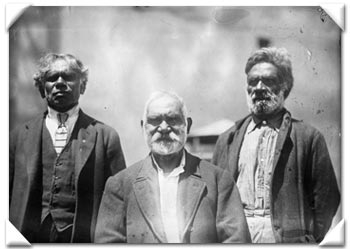
Aboriginal Rights Page 3
- Early European Impact

- The Stolen Generations
- The Aboriginal Response
- David Unaipon
- After World War II
- The 1967 Referendum
- The Aboriginal Flag
- Aboriginal Deaths in Custody
- First International Indigenous Women's Conference
- Eddie Mabo
- Hindmarsh Island [Kumarangk] Bridge
- Your house is not our house
- Future Directions
Aboriginal response
The lack of any recorded Aboriginal version to the arrival of Europeans in Tandanya means that for the most part we must depend on the European record. Early reports suggest the Kaurna people to a degree welcomed, even if they did not entirely trust, the new arrivals. With the initial small population of settlers opportunities for conflict were few.
When conflict did occur it was most often due to different cultural expectations and concepts of property. In 1842, Kaurna man, Monyitya, received a public flogging for the theft of a watch, and in May 1851, a shepherd on Eyre Peninsula was speared to death by Aborigines. Predictably any attempts by the Aboriginal people to protect themselves and their lands from the advancing European migration resulted in their defeat and punishment.
At a judicial level Europeans had no understanding of Aboriginal justice and typically enforced their own laws. In May 1851 The Adelaide Times reported that four "Aboriginal natives of this province, were indicted for murdering an Aboriginal native named Mayponin ... at Robe Town." The four were acquitted for lack of evidence, with their defense lawyer stating they should be "placed in no worse position than the whites". But not all the colonists were so generous and in the same month Charles Jacques and Jeremiah Nicholls were charged with the shooting murder of an Aboriginal man in Kapunda following a disturbance outside Willoughby's public house.
For the most part any significant Aboriginal response to the Europeans remained on European terms. The 1860 Select Committee report upon 'The Aborigines' took ninety eight pages of evidence from seventeen European men but only one page from two Aboriginal men and one Aboriginal woman. The 1913 Royal Commission on 'The Aborigines' took evidence from several Aboriginal men, including David Unaipon and Matthew Kropinyeri. There is considerable discussion related to the removal of children for the purposes of training, and some disparity between the intention of removing children and the reality they experienced. When asked, "At what age do you think the children could be taken away?", David Unaipon replied, "As soon as they leave school, at the age of 9 or ten years". To which the Chairman asked, "Do you think your people would be pleased to hand over the boys and girls to be apprenticed to trades?" and Unaipon replied, " Yes, I think so. I do not think there would be any objection as long as the parents know that the children were put into good hands, put in the hands of someone they could trust." Matthew Kropinyeri initially endorsed these comments but apparently after some consideration sought to clarify his position. In an addendum to his evidence written on 6 May 1913 he states, "In regard to the taking of our children in hand by the state to learn trades, &c., our people would gladly embrace the opportunity of betterment for our children; but to be subjected to complete alienation from our children is to say the least an unequalled act of injustice, and no parent worthy of the name would either yield to or urge such a measure."
In 1923 despite the protestations of the Aboriginal community the state government passed The Aborigines (Training of Children) Act, mentioned above. In response to the legislation three Aboriginal men, John Stanley, Willy Rankine and Leonard Campbell travelled from Point McLeay to Adelaide to petition the government and present a memorial written by Ellen Kropinyeri. The memorial noted, the "Act, which, hitherto had been illegal and I believe punished by law, is now legal and supported by law." [Register 21/12/1923].
The petitioners failed to change the government's position and the removal of Aboriginal Children continued into the 1970s.
David Unaipon
David Unaipon, a Ngarrindjeri man, was possibly the first widely acknowledged Aboriginal activist of his time. Born at Raukken in 1872, his reputation as author, inventor and public speaker during the first half of the 20th century contradicted the prevailing white prejudices about Aboriginal people. But it was a combination of world events that changed white Australian attitudes and forced Australian governments to abolish policies such as the White Australia policy. The first and second world wars brought increasing numbers of white Australians into contact with Aboriginal servicemen and women, personal contact broke down prejudices fostered by ignorance. Also post war anti-colonial developments such as the Universal Declaration of Human Rights signed by Australia high lighted the contradiction between Australian rhetoric and policy.
Links:
Aboriginal Family Support Services - South Australia
Australian Human Rights Commission - Bringing them home _History South Australia
HREOC Aboriginal and Torres Strait Islander Social Justice Commissioner reports
Items 13 - 24 of 29














